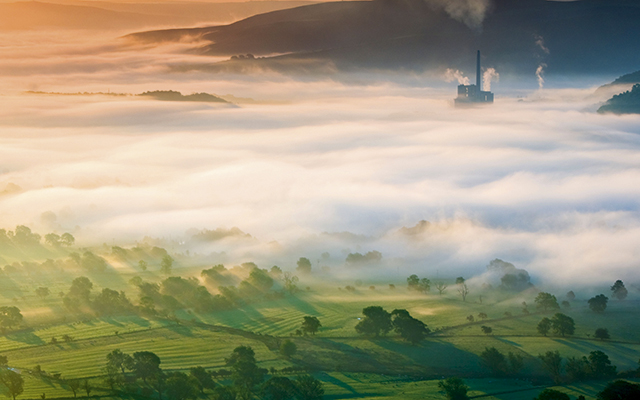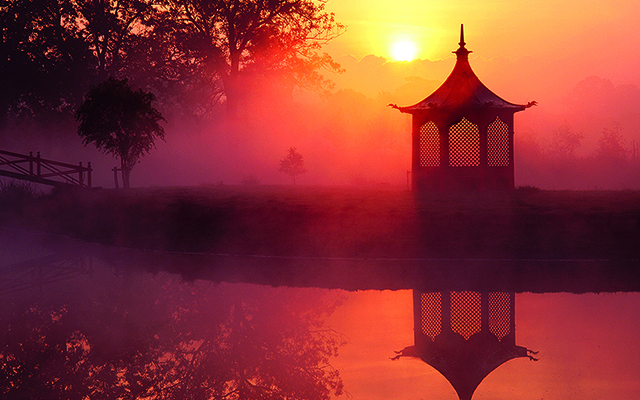Country Life examines the magic of mist and fog in our landscape
In a particularly dismal suburb of Glastonbury all kerbs and sodium lights there is a road sign that, throughout my Somerset childhood, always caught my eye. It bears a single word: ‘Avalon’. For years, I assumed it was a cruel joke: how, in the name of Merlin and Excalibur, could such a place be connected with King Arthur’s legend? And yet, in my mind, I simultaneously held—hold—another view of Glastonbury. It’s from the A39 Wells road as it snakes down off the Mendips. On autumn mornings, with the Somerset Levels hidden beneath a sea of fog, just the Tor is left floating above. Did someone question the whereabouts of Avalon? Such is the effect of a little mist.
Mist and fog are one of the perks of our damp, temperate, maritime climate. Possible at any time, but most frequent after cold, clear nights during autumn and winter, these airborne water droplets are really low cloud so low that we’re granted the astonishing, surreal experience of being able to walk through them. By coming down to Earth, they cross the subconscious boundary that separates the ethereal romance of the Heavens from the tawdry, sharp-edged physicality of terrestrial reality and, in doing so, they crowbar a little wonder into even the most impervious lives.
Longer views acquire a graphic simplicity. Lower parts of the landscape, where mist usually collects, become airbrushed white. Higher ground becomes compressed—telephoto style into a series of darker ridges silhouetted against paler vales beyond. Vertical elements on these ridges—towers, steeples, trees are picked out clear as the spikes of an electrocardiograph.
The feelings that such atmospheric high jinks evoke are trickier to address, as they inevitably vary according to the mind and mood of each individual. What to some may be eerie, others consider exquisite, but it’s safe to assume that most of the usual suspects the transience and fragility of life, mortality, the melancholy of beauty, the euphoria of hope are there.
‘Why is summer mist romantic and autumn mist just sad?’ wonders Dodie Smith in I Capture the Castle. To which the obvious riposte is: ‘Because autumn mist accompanies a lower sun, starker landscape and dying leaves.’ Most importantly, however, what these effects do is force us to look again, to reappraise what we thought we knew.
Plainly, some minds are more susceptible to this stuff than others. For Wordsworth, tramping up Snowdon through ‘a dripping fog, low hung and thick’ to catch the sunrise, the experience of emerging above the ‘silent sea’ triggered a quasi-religious experience. ‘There I beheld the emblem of a mind/That feeds upon infinity, that broods/Over the dark abyss.’
Fog, needless to say, is divisive. Unsurprisingly, perhaps, its appeal depends largely on whether the beholder is immersed within it, or ensconced smugly on a hill above in dazzling sunshine. As a nation, our favourite literary fog is probably the one that hangs over Dartmoor’s ‘Grimpen Mire’ on an October night at the turn of the 19th century: ‘Holmes… muttered impatiently as he watched its sluggish drift. “It’s moving towards us, Watson.”
“Is that serious?”
“Very serious, indeed.”’
And there lies the essential difference between mist and fog. Fog is serious. Where mist is benign, playful, poetic and tantalising, fog is not. Fog masks, suffocates, lies in wait, hiding ferocious hounds with phosphorescent teeth. Accordingly, although fog has been enthusiastically co-opted by novelists notably in the urban gothic of Dickens, Stevenson, Wilde and Conan Doyle it has usually been to exploit a negative reputation attributable to London.
Until the Clean Air Act of 1956 took effect, London’s defining quality was its fog. By the late 19th century, visi-bility in the capital sometimes dwindled to 12in so thick you couldn’t see your feet and theatre performances had to be cancelled because the stage was invisible. Even in the 1960s, tourists could still buy souvenir tins of ‘London Fog’.
Not that everyone thought this way. Monet visited London specifically for its fogs and, in February 1901, he was so transfixed by the endlessly changing light over the Thames from his sixth-floor window at the Savoy that he worked on five canvases before breakfast. ‘The beautiful effects,’ he wrote, ‘are scarcely to be believed.’ And he was right, of course as any visitor to Avalon must surely agree.
Antony Woodward lives, for large parts of the year, in, and just occasionally above, dense hill fog an experience described in his book ‘The Garden in the Clouds’









